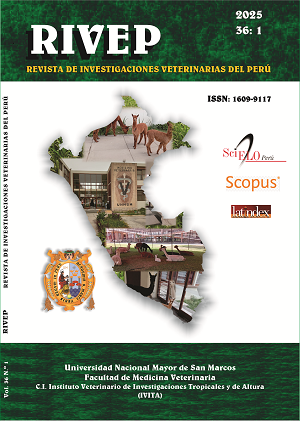Validation into excavated earthen ponds of a finishing vegetable ration supplemented with Schizochytrium sp meal to produce DHA-rich Colossoma macropomum
DOI:
https://doi.org/10.15381/rivep.v36i1.28040Keywords:
docosahexaenoic acid, polyunsaturated fatty acids, additive, gamitana, Amazonian fishAbstract
The aim of the study was to validate a DHA-rich production technology for gamitana, Colossoma macropomum, in excavated earthen ponds by supplying a finishing vegetable ration supplemented with Schizochytrium sp. meal. A vegetable ration (VR) and a vegetable ration supplemented with 5% Schizochytrium sp. meal (DS) were used. A total of 1200 fish (258.90 ± 6.93 g) were distributed in six 200 m3 earthen ponds at a density of 1 fish/m3, and fed with VR for 120 d. Then, fish from three randomly selected ponds continued to be fed VR and the remaining ones were fed DS for 71 d, the minimum period to maximize the DHA content in the gamitana fillet. The feed was provided at 08:30 and 16:30 h at a daily rate of 1.50%. Body growth, proximal content, fatty acid content and nutritional quality of the lipid fraction of the fillet, as well as pH and microbiological characteristics of the fillet were evaluated. Data were analysed by the Student t-test for independent samples (p<0.05). Microbiological evaluation data were based on the maximum permissible limit. The results of the study validated in the field a technology for natural enrichment of gamitana fillet with DHA, demonstrating that it is possible to supply vegetable ration with Schizochytrium sp. meal to gamitanas for 71 days before harvest, without affecting the growth of the fish, guaranteeing its safety (absence of microbiological contamination), without affecting the proximal content of the fillet and increasing the nutraceutical value of the fish in terms of increased DHA, n-3, PUFA content and nutritional improvement of the lipid fraction of the fish meat.
Downloads
Downloads
Published
Issue
Section
License
Copyright (c) 2025 Carlos Andre Amaringo Cortegano, Deykie M. Wong B., César A. Villanueva C., Lluvis L. Germany G., Juan A. Rondón E.

This work is licensed under a Creative Commons Attribution 4.0 International License.
AUTHORS RETAIN THEIR RIGHTS:
a. Authors retain their trade mark rights and patent, and also on any process or procedure described in the article.
b. Authors retain their right to share, copy, distribute, perform and publicly communicate their article (eg, to place their article in an institutional repository or publish it in a book), with an acknowledgment of its initial publication in the Revista de Investigaciones Veterinarias del Perú (RIVEP).
c. Authors retain theirs right to make a subsequent publication of their work, to use the article or any part thereof (eg a compilation of his papers, lecture notes, thesis, or a book), always indicating the source of publication (the originator of the work, journal, volume, number and date).



